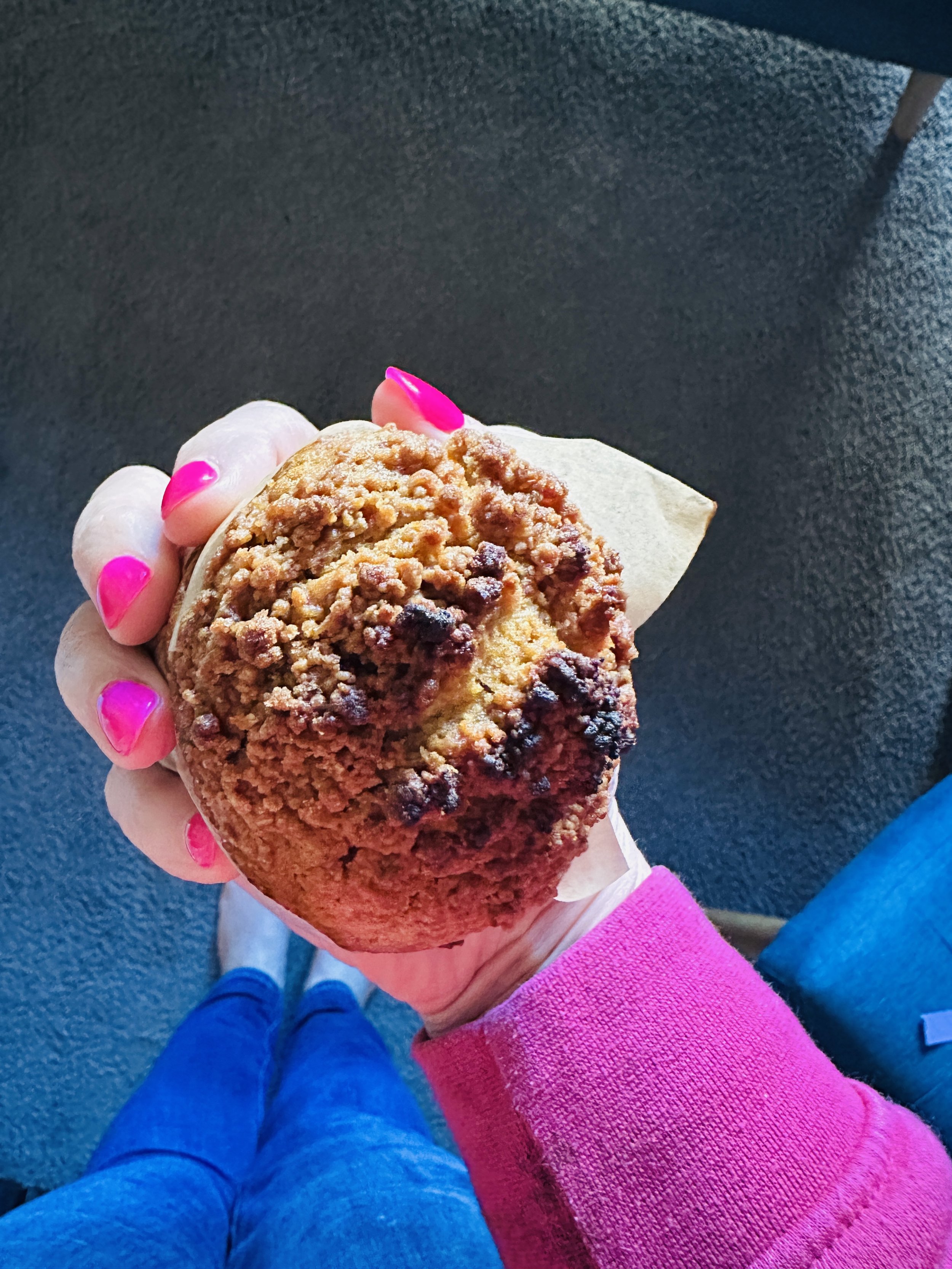In summer and autumn, one is spoiled for choice with different seasonal fruits to use in baking - but winter?
At the start of June, I bought a large box of the last of the blackberry harvest from a local farm. They have been sitting in the freezer, added to breakfast porridge and weekend crumbles, but I wondered about using them in something else. Pears are also plentiful in the supermarket at the moment, particularly the “Odd Bunch” ones, the imperfect specimens that come into their own in cakes, bakes, crumbles and smoothies.
I decided to try this particular wintry (or autumnal, strictly speaking, I suppose) fruit combination in these muffins and it was an absolute winner! Sharp yet sweet fruit set in a vanilla-heavy batter not unlike birthday cake, topped with an indulgent and moreish streusel mixture. Winter elevenses have never been so tasty!
You can of course use whatever fruit you prefer - any kind of berry, fresh or frozen, would work well in place of the blackberries and you could use apples interchangeably for the pears. You could also use all pear (or apple). You want 230g in total of fruit, whatever combination you end up using.
You could also add nuts to the streusel mix if you like - walnuts, almonds, hazelnuts or pecans would be lovely. Nuts can burn easily, though, so be careful!
Pear and blackberry streusel muffins
Inspired by The Full Helping (I love her recipes!)
Makes 6 jumbo “Texas” muffins, probably 12 regular sized ones
Streusel topping
65g plain flour
50g dark brown sugar
65g cold butter (I use a vegan one called Nuttelex Buttery)
1 teaspoon ground cinnamon or mixed spice (I used a Gewürzhaus blend called Hot Cross Bun Spice, which appears to be only available at Easter) [note: only use 1/2 teaspoon if you prefer a subtler cinnamon flavour]
A pinch of sea salt
Muffins
1.5 cups of frozen (or fresh) blackberries + 1 small pear, peeled and cored (230g fruit in total)
350g plain flour
1/2 teaspoon sea salt
1.5 teaspoons baking powder
1 teaspoon bicarb soda
320ml soy milk + juice of half a lemon (or buttermilk if not vegan), combined in a large jug + allowed to sit and coagulate for at least 5 minutes
120ml sunflower or vegetable oil
170g caster or raw sugar
2 teaspoons vanilla extract
Preheat your oven to 180 C and line your muffin tin with cases/liners or squares of baking paper you’ve cut to fit.
Blitz all streusel topping ingredients in a food processor using the pulse function until the mixture is combined and resembles breadcrumbs. Scrape out into a bowl and place in the freezer until the muffin mix is ready.
Just to note, the streusel mix makes way more than you need but it doubles as a crumble mixture, so keep it in the freezer for when you next feel like a crumble and you’ll have dessert in an instant. Half the quantities specified if you don’t want leftovers but you’ll probably have to make it by hand, smaller quantities are trickier to do in a food processor, I’ve found (certainly in mine!).
Prep your fruit for the muffins - peel, core and chop the pear into small pieces and measure out the blackberries. Set aside.
Combine the dry ingredients in a large bowl.
In the large jug where you’ve measured out your soy milk and lemon juice (or buttermilk if you’re not worried about this being dairy free), you should have a slightly thick and lumpy milk now. Use a small whisk to bring it all together, and then add the oil, sugar and vanilla. Whisk well to combine.
Make a well in the centre of the dry ingredients and add the contents of the jug. Mix it together very gently with a spatula until just combined - Delia Smith recommends doing it in a slow figure of eight and this is what I usually do. It’s fine if there are a few small lumps but you don’t want to over-mix otherwise the muffins will be tough, and who wants that?
When the mixture is nearly combined, add the fruit to the bowl and gently fold it in.
A hilarious moment from Schitt’s Creek which ensured I will never be able to say “fold it in” with a straight face ever again! | Source
Once everything is combined, divide the mixture between the muffin containers - I use my favourite giant Texas style pan which yields six muffins.
Sprinkle as much or as little as you like of the streusel mixture on top of each one - I erred on the side of generous.
Bake in the oven for 25-30 minutes depending on the size of your muffins - mine took 30 minutes for a skewer to come out clean. Start checking at around 20 minutes is usually my advice, depending on how hot your oven runs. You can always put them back in for a few minutes, but scorched muffins are a sorry sight indeed!
Allow to cool - they were great warm but I enjoyed them even more a day or two later when they were firmer. Keep them in a container and I’ve found they last very well, over a week - but at that stage, they benefit from a quick warm up in the oven or microwave.
Savour them with a cup of steaming tea or coffee, and revel in the many consolations of winter.





